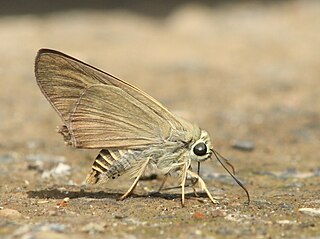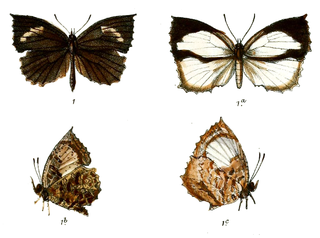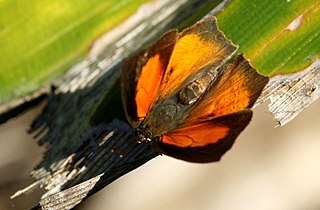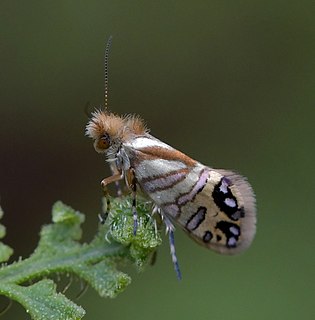
The small angle shades is a moth of the family Noctuidae. It is distributed throughout the Palearctic. The species was first described by Carl Linnaeus in his 1758 10th edition of Systema Naturae.

Badamia exclamationis, commonly known as the brown awl or narrow-winged awl, is a butterfly belonging to the family Hesperiidae. It is found in south and southeast Asia, Australia, and Oceania.

Allotinus drumila, the crenulate darkie, is a small butterfly found in India, Burma, Thailand, Laos, Vietnam, and Yunnan (China) that belongs to the lycaenids or blues family.

Arhopala centaurus, the centaur oakblue or dull oakblue, is a species of lycaenid or blue butterfly found in India and southeast Asia to the Philippines.

Hasora anura, the slate awl, is a species of hesperid butterfly found in Asia. In India it is found in Sikkim and the Khasi Hills.

Curetis acuta, the angled sunbeam, is a species of butterfly belong to the lycaenid family. It is found in Indomalayan realm. Curetis acuta is sexually dimorphic, the sexes differing in dorsal coloration of the wings, however their ventral wings are similar and of silver color which reflects sunlight. The reflection of light by silver ventral wings plays a role of signalling during flight, camouflage while at rest or during hibernation, and lowering body temperatures by reflecting the sunlight.

Rathinda is a butterfly genus in the family Lycaenidae. It consists of a single species, Rathinda amor, the monkey puzzle, found in Sri Lanka and India.

Grammodes stolida, the geometrician, is a moth of the family Erebidae. The species was first described by Johan Christian Fabricius in 1775. It is found in Africa, southern Europe, most of Asia and Australia. It migrates to central and northern Europe as far north as England, Denmark and Finland.

Sabatinca doroxena is a species of moth belonging to the family Micropterigidae. It is endemic to the North Island of New Zealand. This small moth has a colourful forewing pattern with stripes and dots evident. It has been hypothesised that the forewing pattern is intended to resemble a jumping spider in order to allow the adult moth to escape predation. Adults of this species are on the wing from the beginning of September until mid January. It prefers damp but sunny habitat in deep forest, at the forest edge or in open shrubland. Larvae feed on foliose liverwort species including on Heteroscyphus normalis. Adults of this species have been located at the blossoms of flowering Cordyline and Ranunculus species.
Drapetodes lunulata is a moth in the family Drepanidae. It was described by Warren in 1896. It is found in Indonesia (Java).

Nordstromia bicostata is a moth in the family Drepanidae. It was described by George Hampson in 1912. It is found in Sikkim in India, Sichuan in China, Nepal and northern Myanmar.
Nordstromia humerata is a moth in the family Drepanidae. It was described by Warren in 1896. It is found in north-eastern India.
Thymistadopsis undulifera is a moth in the family Drepanidae. It was described by George Hampson in 1900. It is found in Tibet, China.
Epipsestis castaneata is a moth in the family Drepanidae. It was described by Warren in 1915. It is found in Sikkim in India, Hunan in China and in Nepal and Vietnam.
Habrona marmorata is a moth in the family Drepanidae. It is widely distributed in Papua and Papua New Guinea.
Macrothyatira flavimargo is a moth in the family Drepanidae. It is found in western China.
Nothoploca nigripunctata is a moth in the family Drepanidae. It is found in India, Vietnam, Korea, China and the Russian Far East.
Euchaetis endoleuca is a moth in the family Oecophoridae. It was described by Edward Meyrick in 1888. It is found in Australia, where it has been recorded from South Australia and Western Australia.
Garrha costimacula is a moth in the family Oecophoridae. It was described by Edward Meyrick in 1883. It is found in Australia, where it has been recorded from Queensland and New South Wales.
Antaeotricha bicolor is a species of moth of the family Depressariidae. It is found in Brazil.









